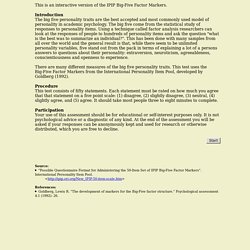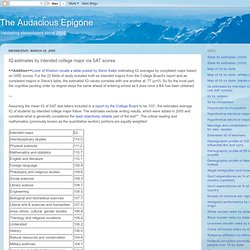

Big Five personality traits. In psychology, the Big Five personality traits are five broad domains or dimensions of personality that are used to describe human personality.

The theory based on the Big Five factors is called the five-factor model (FFM).[1] The five factors are openness, conscientiousness, extraversion, agreeableness, and neuroticism. Acronyms commonly used to refer to the five traits collectively are OCEAN, NEOAC, or CANOE. Beneath each global factor, a cluster of correlated and more specific primary factors are found; for example, extraversion includes such related qualities as gregariousness, assertiveness, excitement seeking, warmth, activity, and positive emotions.[2]:24 The Big Five model is able to account for different traits in personality without overlapping. Empirical research has shown that the Big Five personality traits show consistency in interviews, self-descriptions and observations. §Five factors[edit] Openness to experience: (inventive/curious vs. consistent/cautious). Ipip.ori.org/newFinding_Labeling_IPIP_Scales.htm. Finding (and Labeling) IPIP Scales At the link labeled "Multiple Constructs," there is a list of IPIP multi-scale inventories, including several based on either the lexically derived Big-Five factor structure or Costa and McCrae’s Five-Factor Model.

As is the case with most IPIP scales, these were developed by identifying IPIP items that, when summed into a scale, correlate highly with an existing measure. The first three inventories, under the heading "The Big-Five Factor Structure," are IPIP measures designed to correlate with five-factor scales whose items are trait adjectives. The first of these is labeled "Big-Five 5 Broad Domains. " If one follows its link labeled “Comparison Table,” one will find descriptions of both 50-item and 100-item IPIP inventories designed to correlate highly with the five adjective markers described in the following article: Goldberg, L. Although none of the IPIP scales have official names, one should refer to them by the scales on which they are based. Free Online Personality Tests.
The Big Five Personality Test. This is an interactive version of the IPIP Big-Five Factor Markers.

Introduction The big five personality traits are the best accepted and most commonly used model of personality in academic psychology. The big five come from the statistical study of responses to personality items. Using a technique called factor analysis researchers can look at the responses of people to hundreds of personality items and ask the question "what is the best was to summarize an individual? ". This has been done with many samples from all over the world and the general result is that, while there seem to be unlimited personality variables, five stand out from the pack in terms of explaining a lot of a persons answers to questions about their personality: extraversion, neuroticism, agreeableness, conscientiousness and openness to experience.
There are many different measures of the big five personality traits. Procedure This test consists of fifty statements. Academic achievement, income, IQ. International Personality Item Pool. Students: The 9 things that matter more than GPA. IQ estimates by intended college major via SAT scores. ++Addition++Lover of Wisdom recalls a table posted by Steve Sailer estimating IQ averages by completed major based on GRE scores.

For the 22 fields of study included both as intended majors from the College Board's report and as completed majors in Steve's table, the estimated IQ values correlate with one another at .77 (p=0). So for the most part, the cognitive pecking order by degree stays the same ahead of entering school as it does once a BA has been obtained. Assuming the mean IQ of SAT test-takers included in a report by the College Board to be 103*, the estimated average IQ of students by intended college major follow.
The estimates exclude writing results, which were added in 2005 and constitute what is generally considered the least objectively reliable part of the test**. The critical reading and mathematics (previously known as the quantitative section) portions are equally weighted: Nothing too terribly surprising. Again, pretty predictable.